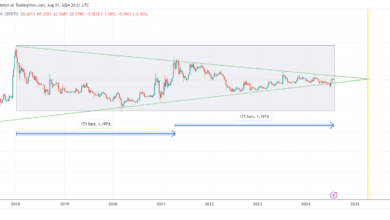Avalanche Layer-1: Exploring the Impact of the Etna Upgrade

Avalanche Layer-1 is revolutionizing the blockchain landscape with its robust architecture and innovative features. Recently, the platform underwent the Etna upgrade, which aimed to enhance flexibility for developers and optimize transaction efficiency within the Avalanche ecosystem. This significant update has sparked interest among investors, particularly in light of the current trends impacting the AVAX price. Amid the growing need for effective blockchain scaling solutions, Avalanche Layer-1 stands out by empowering decentralized applications like Dexalot DEX to flourish. As the crypto market evolves, this advanced approach could position Avalanche as a leading contender for future blockchain adoption.
The advancements of Avalanche Layer-1 mark a pivotal moment in the evolution of blockchain technology. By introducing sophisticated features through the recent Etna upgrade, the platform aims to streamline development processes and reduce overhead costs. This evolution resonates within the broader context of blockchain scaling, reflecting a growing demand for adaptable solutions across the industry. Meanwhile, projects such as Dexalot DEX illustrate the exciting possibilities within the Avalanche ecosystem, showcasing a vibrant landscape for new financial applications. As the quest for reliable and efficient Layer-1 solutions continues, the potential for Avalanche to redefine the space is more than promising.
Understanding Blockchain Scaling
Blockchain scaling is a fundamental challenge that defines the effectiveness and efficiency of decentralized networks. Approaches to scaling can largely be categorized into two main architectures: modular and monolithic. Modular architectures break down blockchain functions into specialized layers which may include execution, settlement, consensus, and data availability. This type of architecture allows for specialized chains like Celestia to handle data availability while using chains like Ethereum to execute transactions. On the other hand, a monolithic approach consolidates these functionalities within a single blockchain solution. Solana exemplifies this method by combining all aspects into a unified framework. Despite the growing interest in multi-chain systems like Cosmos, user adoption remains limited, highlighting an ongoing debate within the blockchain community about the best path forward.
Recent developments such as Hyperliquid—a pioneering Perps-DEX on a Layer-1—have challenged the notion of scaling via modular or monolithic architectures. The decentralized finance (DeFi) space is always evolving and demonstrates the need for versatile frameworks that can cater to various use cases. Within this context, Avalanche’s unique stance aims to synthesize both architectures. By maintaining high activity on its C-Chain and allowing developers to create tailored Avalanche Layer-1s, the network optimizes user experience and enhances operational efficiency. This hybrid approach could potentially solidify Avalanche’s position in the rapidly advancing blockchain arena, especially as new players emerge looking to carve out niches in crypto applications.
The Impact of the Etna Upgrade on AVAX
The Etna upgrade, which debuted in December 2024, has emerged as a pivotal moment for the Avalanche ecosystem. Known as Avalanche9000, this upgrade introduced significant changes designed to lower economic barriers for developing customized Avalanche Layer-1s. The Avalanche Community Proposal (ACP-77) effectively dismantled existing requirements that demanded subnet validators also partake in mainnet validation and stake a minimum of 2000 AVAX tokens. With this shift, developers now have the autonomy to set their own parameters without adhering to the previous constraints. This newfound flexibility is anticipated to enhance AVAX adoption by enabling more independent development and innovation within the ecosystem.
As a result of the Etna upgrade, the transaction fees on the Avalanche C-Chain have seen a dramatic decrease from 25 nAVAX to just 1 nAVAX, reflecting a more favorable economic environment for users. This reduction not only fosters greater transaction activity but also amplifies the overall utility of the Avalanche platform. The adjustments made via Etna have sparked a noteworthy increase in transaction volumes, illustrating that even under market pressures, innovative upgrades can lead to sustained interest and adoption. Moving forward, the success of the Etna upgrade will be a crucial factor as Avalanche seeks to navigate the complexities of the DeFi landscape and maintain competitiveness against its peers.
Dexalot DEX: Shaping the Future of Layer-1s
Amidst the shifting dynamics following the Etna upgrade, Dexalot, a novel decentralized exchange (DEX), has quickly established itself as a frontrunner within the Avalanche ecosystem. Standing out with impressive trading volumes, Dexalot is catching up to the Avalanche C-Chain, achieving approximately 45% of its transaction volume. This rapid expansion highlights the platform’s potential to revolutionize how trading occurs within the Avalanche framework. Daily transactions are increasingly frequent, showcasing robust growth that could position Dexalot as a viable competitor not only among Avalanche’s Layer-1s but across the wider DeFi space.
Dexalot’s recent success aligns with an emerging trend of innovation in decentralized finance, underscoring the importance of features like reduced transaction fees and enhanced user experience. The lower startup costs and customizable structures enabled by the Etna upgrade make it feasible for newer projects like Dexalot to thrive. The strategic integration of Layer-1 solutions is empowering DeFi protocols to explore new avenues of user engagement and functionality, ultimately redefining the competitive landscape. As Avalanche continues to cultivate its ecosystem, the successes of Dexalot and similar projects may inspire others to take the plunge into the burgeoning world of Layer-1 tokens and DEX trading.
Avalanche: Future Prospects and Web3 Adoption
As the cryptocurrency landscape evolves, Avalanche’s foundation—strengthened by the Etna upgrade—positions it as a potential front-runner in the Web3 movement. The burgeoning interest in decentralized applications (dApps) and custom blockchain solutions is indicative of an industry that is eager for innovative infrastructures that meet user demands. With significant initiatives like the $40 million Retro9000 funding program for emerging Layer-1 projects, Avalanche is actively seeking to attract a diverse range of creators and developers into its ecosystem. By tantalizing projects with substantial financial backing, Avalanche fosters an environment ripe for developing next-gen dApps.
Moreover, as the technological framework advances, the potential for Avalanche to penetrate mainstream applications grows stronger. The changes instated by the Etna upgrade are already reaping benefits in transaction fee reductions, thereby encouraging user engagement and retention. If Avalanche can effectively showcase the tech prowess and reliability of its Layer-1 solutions, it could become the go-to blockchain for high-performance applications. This evolution will hinge on attracting notable projects, particularly in areas experiencing a resurgence, like social finance and gamefi, thus driving Web3 adoption forward and establishing Avalanche as a cornerstone of the next generation of blockchain technology.
Frequently Asked Questions
What is the Etna upgrade in the Avalanche Layer-1 ecosystem?
The Etna upgrade, introduced in December 2024, is a significant development for the Avalanche Layer-1 ecosystem, aiming to reduce economic barriers for developers and enhance the flexibility of creating custom subnets. This upgrade allows developers to build their own Avalanche Layer-1s without needing to stake on the mainnet, thus fostering greater independence for these custom networks.
How does Avalanche Layer-1 improve blockchain scaling compared to Solana?
Avalanche Layer-1 approaches blockchain scaling through a dual architecture that optimizes processes for decentralized application-specific use cases, unlike Solana’s monolithic model. By maintaining activity on its C-Chain while allowing developers to create tailored Layer-1s, Avalanche enhances scalability and adaptability within the blockchain ecosystem.
What impact has the Etna upgrade had on the transaction fees in Avalanche Layer-1?
Post-Etna upgrade, the average transaction fees on Avalanche Layer-1’s C-Chain have significantly decreased, dropping from 25 nAVAX to just 1 nAVAX. This reduction has made the network more economical for users and has encouraged a higher volume of transactions across the ecosystem.
How has Dexalot benefited from the changes in Avalanche Layer-1 after the Etna upgrade?
Dexalot, a multi-chain decentralized exchange within the Avalanche Layer-1 ecosystem, has experienced remarkable growth following the Etna upgrade. With total trading volumes reaching around $4.1 billion, Dexalot now approaches the transaction volumes of the C-Chain, demonstrating the potential of new Layer-1s post-Etna.
What role does the Avalanche ecosystem play in the future of blockchain adoption?
The Avalanche ecosystem is poised to play a key role in the future of blockchain adoption by providing a flexible and low-cost environment for developers to launch application-specific Layer-1s. With recent upgrades like Etna, lower transaction fees, and increased funding opportunities, Avalanche is well-positioned to attract innovative projects and drive mainstream adoption in Web3.
Why is the AVAX price important for the Avalanche Layer-1 community?
The AVAX price is crucial for the Avalanche Layer-1 community as it directly affects project funding, user participation, and overall market perception. A stable or rising AVAX price can enhance the viability of projects within the Avalanche ecosystem, including those utilizing the benefits from the Etna upgrade.
What are the advantages of having multiple Avalanche Layer-1s after the Etna upgrade?
Multiple Avalanche Layer-1s provide developers with greater customization, allow for application-specific optimizations, and foster a competitive environment that can lead to accelerated innovation within the Avalanche ecosystem. The flexibility introduced by the Etna upgrade aims to reduce barriers and enhance performance across various blockchain applications.
How might the Avalanche ecosystem attract more projects in the wake of the Etna upgrade?
The Avalanche ecosystem is actively attracting projects through initiatives like the $40 million Retro9000 grant and the infraBUIDL() program, which targets application-specific developments. These funding programs, combined with the benefits of the Etna upgrade, are expected to draw more innovative projects into the network, particularly in the gaming and AI sectors.
| Key Point | Details |
|---|---|
| Performance Comparison | Avalanche remains competitive despite Solana’s relapses and Terra Luna’s downfall. |
| Blockchain Scaling Architectures | Avalanche utilizes a hybrid approach, combining modular and monolithic architectures to optimize its ecosystem. |
| Etna Upgrade Impact | Introduced more flexibility for developers and significantly reduced transaction fees on the Avalanche C-Chain. |
| Emerging Projects | Dexalot and Pulsar show the potential of new Avalanche Layer-1s with increased customization and lower costs. |
| Funding Initiatives | Programs like Retro9000 and infraBUIDL() aim to attract innovative projects to the Avalanche ecosystem. |
Summary
Avalanche Layer-1 is positioning itself as a significant contender in the evolving blockchain landscape. With the recent Etna upgrade enhancing developer flexibility and reducing transaction costs, Avalanche is setting the stage for a potential resurgence. The combination of its unique architectural strategy and new funding initiatives signals a bright future for Avalanche as it seeks to capitalize on the next wave of blockchain adoption. By fostering innovative Layer-1 projects like Dexalot and Pulsar, Avalanche Layer-1 may emerge as a favorite among users in the decentralized finance realm.



